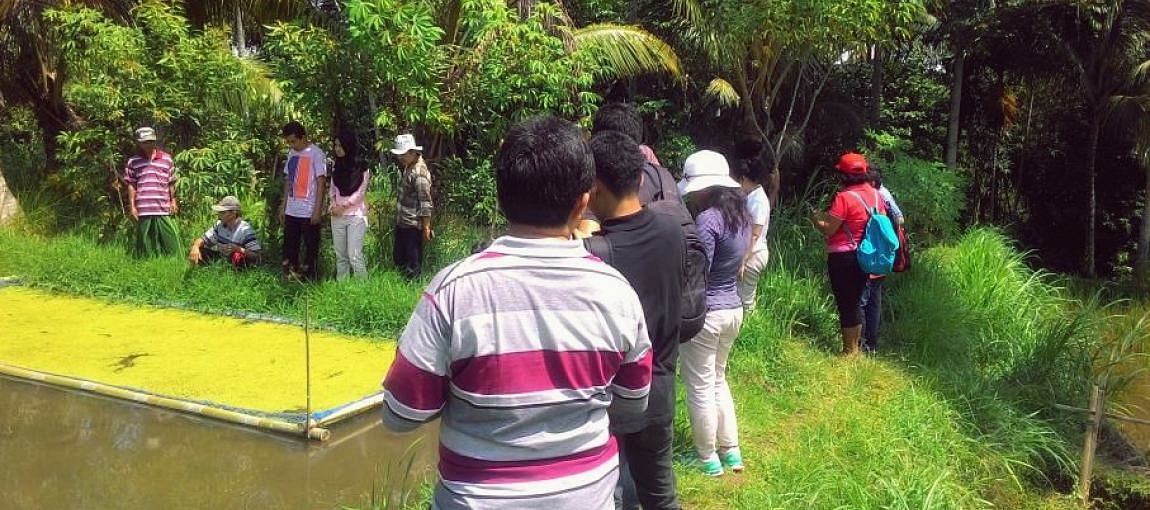
pengetahuanhijau.com - Since the beginning of the journey to the location of socialisation activities to introduce bioslurry organized by HIVOS-Yayasan Rumah Energi (YRE) Consortium, the vastness of fish ponds have dotted the location. The location of this GADING Progrmme is at Bangle Hamlet, Pesanggerahan Village, Montong Gading Subdistrict, East Lombok. The size of the existing ponds are more than ordinary ponds. Some of them have a very large size. The size of the pond is 5 x 10 meter or more. The primary source of income for the local residents are from agricultural activities. Other than farming activities, the community have laid their hopes on freshwater aquaculture. Rice has been the center of cultivated plant as there is sufficient water supply. The abundant potential of water supply has transformed majority of the farmers to switch from rice farmer to fish farmer. Even the techniques of rice-fish system have been widely practiced. Almost every farmer practices such techniques.
Various species have been reared using this system such as nile tilapia and common carps. Product marketing is easier here as it is the buyers who come to the location to source for the products they desire. Buyers have started to order for the fish ever since the farmers stock the ponds with a fry of fish.
Looking into the vastness of the ponds existing in the region with tons of fish to be produced have raised another concern. The problem is the constantly increasing fish feed from day to day. In addressing the condition, it is critical to find solutions to minimize farmers’ expenditures while also finding an ecologically friendly solution. However, the most important thing is that it should be simple enough for the fish farmers to apply these alternatives through materials which are readily and easily available.
The alternative offered is by using natural feedstuff provided by vegetation which is rich in protein and required by the fish. Duckweed or locally known by Sasak people as kembangaik is the plant that suits the description. According to the local people who have not discovered the benefits of the plant, it is often classified as a weed and often time they have to control the growth of this weed by spraying herbicides over the plant. By taking advantage on the natural feedstuff readily available around us is the alternative to a new breakthrough in minimizing the expenditures. Alternative vegetation, as a substitution for a pellet normally used by the community, contains 37.6% of protein content.
One of the fish farmers revealed to the participants visiting the location of aquaculture explained that in addition to protein-rich, duckweed is beneficial to reduce stress experienced by the fish. Stress on the fish may appear during fish transfer process and pond cleaning activities. By feeding the fish with natural feedstuff, we will be able to restore fish appetite.
In order to enhance the growth of duckweed plant then it is necessary to find a solution. The solution is to combine bio-slurry with duckweed. Why does it have to be bio-slurry? The question was raised by one of the fish farmers who participated in the socialisation activities on introducing Duckweed cultivation techniques using bio-slurry. In addition to the benefit of bio-slurry to enhance the duckweed growth, it is also beneficial to enhance the growth of the duckweed which enable to promote the growth of Plankton in the ponds, or in another word one effort, dual advantages.
Previously, HIVOS and YRE had orgnised a socialisation activities on cultivation techniques by putting floating nets to use. These socialisation activities took place on August 16, 2016 at Bangle Hamlet, Pesanggerahan Village, Montong Gading Subdistrict, East Lombok as a follow-up to activities previously organised. This is a concrete effort to improve community economy by taking advantage on existing local resources thus enable the enhancement of community welfare.
These socialisation activities have also been combined with the visit of GADING team from various other regions such as East Nusa Tenggara, Lombok, West Java, and Yogyakarta. The purpose is to directly witness the duckweed cultivation cultured by the farmers and directly listen to the benefits felt by the farmers.


